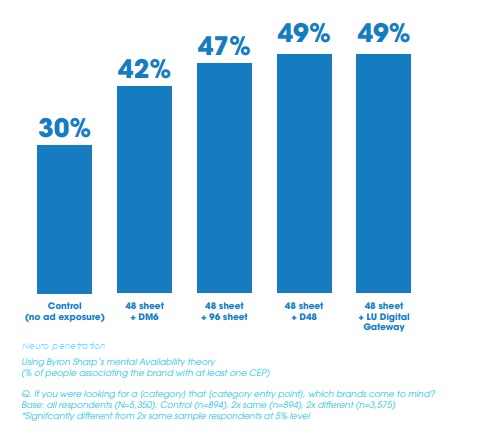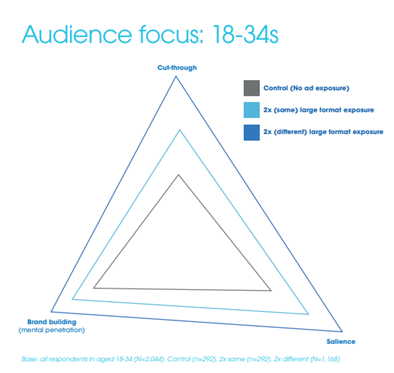A new study reveals how brands can use large outdoor advertising to supercharge reach and connect the dots across a fragmented media landscape.
The secret to brand building really isn’t a secret at all.
Marketing gurus like Les Binet, Peter Field and Byron Sharp reasoned that to grow brands effectively, marketers need the right balance between long-term brand building and short-term sales activations. In the Long and Short of It, Field and Binet suggest a 60/40 split in favour of brand building.
But it wasn’t until the pandemic that these principles evolved from theory into reality. When the context of our lives changed, brands invested in improving visibility over all else. Established brands tapped into their cultural heritage to reassure consumers – and newly forged D2C brands leveraged mass-market messaging to migrate from niche corners to the main stage.
Now the context is changing again. The cost-of-living crisis and inflation means that price is, for many brands, a weaker point of differentiation. Equally we see that human issues – such as sustainability, equality and diversity – are increasingly important to consumers. People want to see how brands fit into a fairer, greener society.
Brands want to express their values and address the concerns of their audiences through mass reach media. But the media landscape is fragmenting – and traditional go-to channels like TV are increasing in cost as they decline in reach. They need to bridge this gap in a cost-effective way.
So how effective are channels like outdoor in this context? How can advertisers measure the impact of brand campaigns? What metrics should they use?
Brand is back
Global’s new report, Multiplicity, explores the role of large format outdoor in fulfilling today’s brand challenges.
The study reviewed the impact of outdoor ads on a nationally representative group of more than 5,350 individuals, who were shown 90-second videos of people driving and walking before being interviewed. It is the largest study of its type to ever be conducted in outdoor advertising.
The overarching aim was to understand the impact of outdoor advertising through three elemental metrics:
- Cut-through – spontaneous advertisement awareness.
- Salience – the brand is spontaneously associated with the category.
- Neuro penetration* – the proportion of people that associate a test brand with at least one category entry point or buying situation, meaning that the brand is readily available in a buying situation.
Neuro penetration is the most important metric in helping to build mental availability, which is how strongly a brand is associated with buying situations. A campaign which increases mental availability increases the probability that a buyer will recognise, notice or think of a brand when considering a purchase. It is a critical metric for measuring how much a campaign really builds a brand.
“To be bought, a brand must first be thought of – the breadth and strength of a brand’s links to relevant category cues determine the chance of this happening.” – Byron Sharp and Jenni Romaniuk, How Brands Grow, Part Two
Understanding multiplicity
The study asked all participants to spontaneously recall which brands they had seen advertised recently for the categories being investigated – including car brands, car buying and selling sites, mobile phone networks, credit card providers and banks.

The above chart shows that 20% of those in the control sample (those with no ad exposure within the study) named one of the test brands. This rose to 38% of those exposed to two 48 sheets, and up to 50% of those exposed to two different large outdoor formats.
This equates to a 90% uplift from the control to the first test sample and a 150% uplift in advertising cut-through when people are exposed to two different large format creatives, clearly demonstrating a multiplier effect.
We could also see the impact on neuro penetration. It was recorded at 30% in the study’s control sample, meaning that one in three of our sample already linked one of our test brands to a category entry point. This figure increased to 42% for people who were exposed to large format advertising, and rose again to 47% when participants saw outdoor ads in different large formats or environments. Overall, the study recorded a 57% uplift after exposure to multiple types of large format outdoor advertising.

Due to the large sample size, this study was able to assess how different demographics were influenced. The chart below shows that even for the 18–34-year-old audience (the group that is in sharpest decline among falling broadcast audiences) cut-through, salience and mental penetration all witnessed significant impacts – with an uplift in cut-through of 156% from control to two different large format exposures.

The writing’s on the wall
These statistically significant uplift figures show that large format outdoor cuts through – people are between two and three times more likely to name ads for brands that appeared in the test videos, compared to those from our control sample.
The conclusion is twofold. Firstly, that large format outdoor advertising cuts through and delivers an incremental impact on advertising recall. Secondly, combining multiple large outdoor formats delivers significantly greater cut-through. Seeing an ad multiple times on one journey greatly builds mental availability, increasing the chance of recall and action.
Brand building is back to the top of the agenda for marketers. We know the theories. We know the channels. And through Multiplicity we can see exactly how brands can use large outdoor advertising to supercharge reach and connect the dots across a fragmented media landscape.
*Defined by Byron Sharp as Mental Penetration in his book How Brands Grow.

